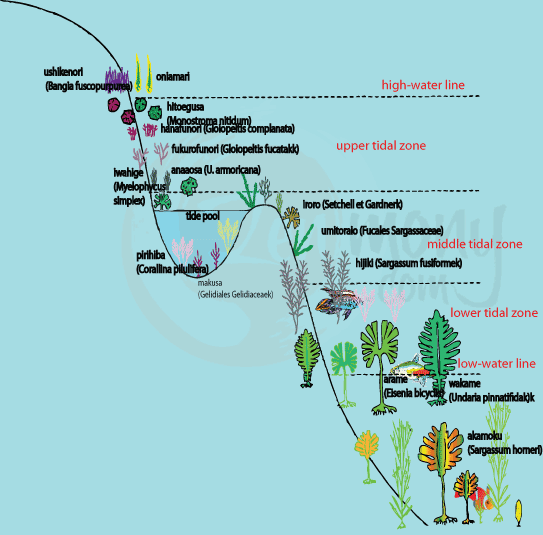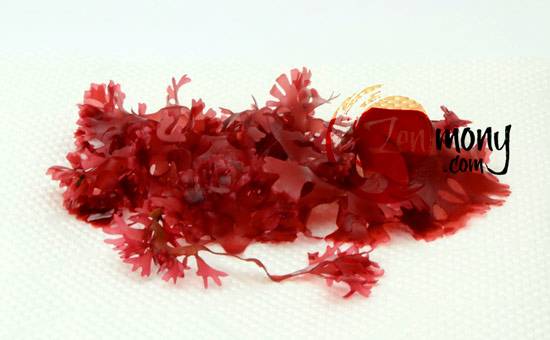| 2015 | APR | |||||||
| 2014 | JUL | OCT | DEC | |||||
| 2013 | JAN | FEB | APR | MAY | JUN | JUL | AUG | SEP |
| 2012 | SEP | OCT | NOV | DEC |
Seaweed & Hair Health Benefits – Introduction
- Role of seaweed in the life of the Japanese people.
- About seaweed.
- Why do different types of seaweed have different colors?
- Seaweed is considered to be the treasure house of minerals.
 It is not a secret that seaweed plays an important role in the life of the Japanese people. Almost everybody in Japan has heard from their parents and their grandparents about seaweed and its health benefits (especially for hair). According to some scientists, seaweed has been used in food in Japan starting as early as the New Stone Age (about 10,000 years ago). From the multiple fossil remains available today, we can assume that ancient inhabitants of Japan consumed large amounts of seaweed, such as arame (Eisenia bicyclis), hondawara (Sargassum fulvellum), hijiki (Hizikia fusiformis), and wakame (Undaria pinnatifida), all of which are believed to help hair grow healthy and abundant.
It is not a secret that seaweed plays an important role in the life of the Japanese people. Almost everybody in Japan has heard from their parents and their grandparents about seaweed and its health benefits (especially for hair). According to some scientists, seaweed has been used in food in Japan starting as early as the New Stone Age (about 10,000 years ago). From the multiple fossil remains available today, we can assume that ancient inhabitants of Japan consumed large amounts of seaweed, such as arame (Eisenia bicyclis), hondawara (Sargassum fulvellum), hijiki (Hizikia fusiformis), and wakame (Undaria pinnatifida), all of which are believed to help hair grow healthy and abundant.
The Japanese people have long known that the various types of seaweed are good for our body in many ways, but it is only recently that there has been any substantial scientific grounds to support these beliefs. The first serious scientific research endeavor into the effects of seaweed on hair started about twenty years ago in Japan, research that was possible because of advances in the field of molecular biology. The results of these first studies spurred a slew of new research with the goal of creating new hair growth formulae.
Alopecia, or hair-loss, has been causing distress since ancient times. Around 400BC, Aristotles writes: "Among all animals, humans bald most." Many historical figures, like Julius Caesar, for example, were troubled about their hair loss. On the other hand, long and healthy hair has always been a symbol of strength and power, as evidenced by the story of Samson and Delilah in the Old Testament. Presently, more than ten million people in Japan alone are anxious about the health of their hair.
About seaweed
The seaweed that most people know is the so-called large-sized sea algae, which includes green algae (Chlorophyceae), brown algae (Phaeophyceae), and red algae (Rhodophytes or Rhodophyceae). Seaweed also includes the lesser-known species, such as blue-green algae (Cyanobacteria) and microalgae. In total there are more than 25,000 known algae species today, not including Cyanobacteria and microalgae. Among these 25,000 known species, aosa (Sea lettuce), aonori (Enteromorpha), and other green seaweed comprise around 6,500 species (125 genera); konbu (Laminaria japonica), wakame (Undaria pinnatifida), and other brown seaweed make up about 1,500 species (240 genera); and tengusa (Agar-agar, Gelidium amonsii), funori (of genus Gloiopeltis), and other red seaweed make up for another 4,000 species (400 genera). Modern scientists believe that the oceans on the Earth were formed about three billion years ago. It took another few hundred million years before the first unicellular plants were born, with several million more years before the first invertebrates were born. Only after that did the ancestors of modern seaweed finally appear on the Earth. Around six hundred million years ago, with the rise of seaweed, bivalves and spiral shells first appeared. About ten million years ago, the Japanese Archipelago was formed and countless types of seaweed flourished in its wateres. There is proof that the first representatives of Homo sapiens set foot on Japanese soil about two million years ago, and it is believed that since then, seaweed has been an inseparable part of the people of Japan.
Among the three major algae species (red, brown and green), red seaweed appeared on the Earth first. It took almost 1.7 billion years for the ancient blue-green algae Cyanophyceae to form the first ozone layer on Earth (which helped decrease the amount of UV radiation), before the conditions where the first red seaweed could live were created. Compared to the unicellular blue-green algae, red algae were multicellular, and each of their cells had a blast made of a nucleus with DNA and the two-layered membrane containing the pigment. Red algae commonly have a ramificated branch structure, but other, more advanced species have hair-like structures with absorbing ability (made possible with the sulfated galactose polymer cell walls), as in the leaves of developed terrestrial plants. These kinds of seaweed contain either carrageenan low in sulfate content or agar high in sulfate content, which defines their thickening and gelling properties and makes them usable in the food and cosmetics industries. About 130 million years before humans came into existence, oxygen created by both blue-green algae and red algae created an ozone layer thick enough so sea layers closer to the surface could be inhabited, marking the birth of the green algae (Chlorophyceae). This type of a seaweed has only one pigment, chlorophyll, which defines its characteristic color - green. Among green seaweed, there are both unicellular (e.g., chlorella) and multicellular representatives, the latter of which posess long stringlike cell structures. Cells in green seaweed have a blast made of a nucleus and the two-layered membrane.
Finally, about 100 million years ago, the fourth group of seaweed was born - the brown seaweed (Phaeophyceae). This new type of seaweed contained chlorophyll and a brown pigment called fucoxanthin. This seaweed could live in the relatively shallow sea waters (about 150 meters deep) and contained valuable polysaccharides, such as alginic acid and fucoidan.
Why do different types of seaweed have different colors?
 As we go deeper into the sea, the amount of light that can reach the seaweed lessens and the quality of light itself also changes. Generally, it can be said that green seaweed inhabits the most shallow sea waters, while brown seaweed lives a little deeper, and red seaweed grows at the deepest levels of the three. Chrolophyll a is a lipid-soluble pigment present in all seaweed species. Its main function is to absorb solar energy and transform it into molecule excitation energy. The types of seaweed that cannot absorb solar energy directly with chlorophyll a first absorb it with the use of auxuliary pigments and later transfer it to chlorophyl a. In brown seaweed, lipid-soluble carotenoid fucoxanthin performs this function, and in red seaweed, water-soluble phycoerythrin (red color) and phycocyanin perform this function.
As we go deeper into the sea, the amount of light that can reach the seaweed lessens and the quality of light itself also changes. Generally, it can be said that green seaweed inhabits the most shallow sea waters, while brown seaweed lives a little deeper, and red seaweed grows at the deepest levels of the three. Chrolophyll a is a lipid-soluble pigment present in all seaweed species. Its main function is to absorb solar energy and transform it into molecule excitation energy. The types of seaweed that cannot absorb solar energy directly with chlorophyll a first absorb it with the use of auxuliary pigments and later transfer it to chlorophyl a. In brown seaweed, lipid-soluble carotenoid fucoxanthin performs this function, and in red seaweed, water-soluble phycoerythrin (red color) and phycocyanin perform this function.
Seaweed is considered to be the treasure house of minerals.
Most health benefits that have been recently discovered in seaweed are no doubt due to the precious minerals found in them. Minerals are known to perform three main functions inside the human organism:
- As slightly soluble mineral salts: calcium, phosphorus, etc. needed for bones and teeth.
- As organic compound constituent elements: phosphorus in nucleic acid and ATP, iron in hemoglobin, etc.
- As inorganic ions: pH regulation of body fluids, osmotic pressure regulation, muscular contraction, and neuronal excitement transmissions.
There are 60 different minerals found in seawater. Seaweed is known to absorb and accumulate many of these minerals. As per Noda et al, the relative density (relative to seawater) of sodium, magnesium, calcium, and some other minerals found in most seaweed is about 1, but for the microelements, these numbers are much higher: iron is about 1,000 to 130,000, and iodine is 500 to 60,000 (these numbers greatly depend on the species of seaweed and on the environment where it was grown). Among all minerals contained in seaweed, carbohydrates attract the most attention with regards to the possible health benefits. In turn, polysaccharides (especially alginic acid and fucoidan) are the most-studied minerals among all the carbohydrates found in seaweed. All polysaccharides found in seaweed can be divided into three categories: frame polysaccharides, mucopolysaccharides, and storage polysaccharides. The main function of polysaccharides in seaweed is thought to be to protect them from solar radiation, wounds, and malignant bacteria during low tides.
For reference:
- 野田宏行 1987.化学工業 4
- 小林良生 1996.海藻パルプとアルギン酸繊維の紙 p.125-139「21世紀の海藻資源一生態機構と利用の可能性」大野正夫編 緑書房
Check out similar products here